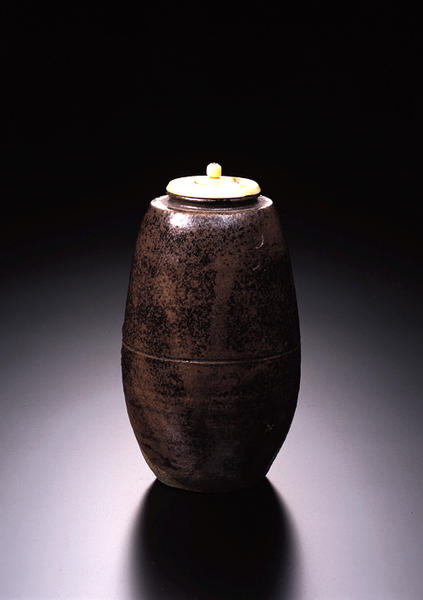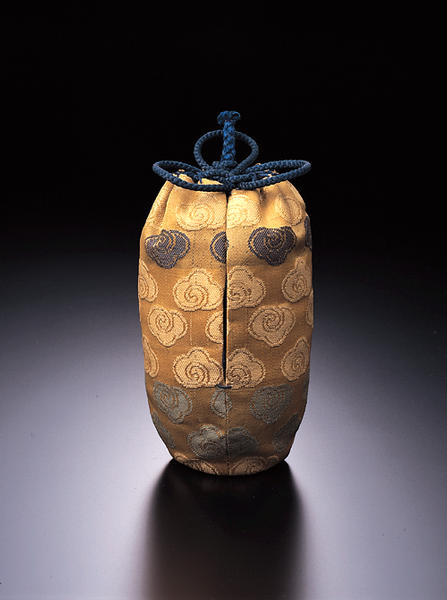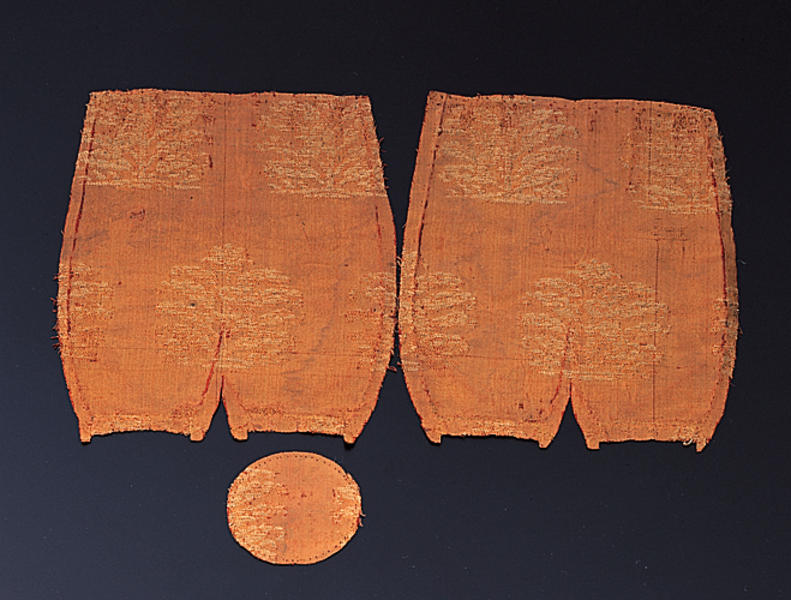瀬戸肩衝茶入 銘 生駒
- 愛知県・瀬戸窯
- 桃山時代
- 16c
- 施陶製
- H-11.9 D-7
- 所蔵
- 徳川家康、生駒讃岐守正俊、京三井家、若州酒井家
桃山時代 16世紀
高:11.9cm 口径:3.9cm 胴径:7.3cm 底径:4.4cm
慶長17年(1612),駿府において徳川家康より生駒讃岐守正俊がこの茶入を拝領し,所持したことによって「生駒肩衝」と言われる。しかし,生駒家は正俊の子高俊の代,寛永17年(1640)に御家騒動のため,領地没収となっている。おそらくそのおりにこの茶入は生駒家を出て,蔵田七郎右衛門の所持するところとなったのであろう。その後,冬木喜平次,三井八郎右衛門と転伝し,『大正名器鑑』編纂のときには若狭の酒井家の蔵であった。この酒井家所蔵の間,天保15年(1844)には谷松屋が金子千五百両を用立て一時「寺沢丸壷」などとともに預かったという経緯もある。
ところで,かつて瀬戸茶入のなかでもとくに大振りなものを三つ取り上げ,大瀬戸茶入と称したようで,この茶入はその一つにあげられている。確かに瀬戸茶入のなかでもかなり大振りで,また姿も整っている。肩幅は狭く,口は低く,またふっくらと張った胴には胴紐がまわり,底には整った糸切りが残っている。釉はなめらかで,一部に釉のむらが現れ,景色をなしている。近年,瀬戸茶入の製作年代が検討されているが,すでに慶長年間より伝来の確かな茶入として注目される作品である。 (赤沼)
Catalogue Entry
Momoyama period, 16th century
Seto ware
Height, 11.9cm; mouth diameter, 3.9cm; torso diameter, 7.3cm; base diameter, 4.4cm
Tokugawa Ieyasu presented this tea container to Ikoma Ikinokami Masatoshi in 1612 (Keicho 17) upon the occasion of Sunpu. This provenance then led to its name "Ikoma katatsuki." Then, however, the Ikoma family had its lands confiscated in 1640 (Kan'ei 17) due to a family quarrel during the headship of Masatoshi's son Takatoshi. It was probably upon this occasion that this tea container left the Ikoma family, and it appears to have then entered the collection of Kurata Shichiroemon. In later years, the container was owned by Fuyuki Kiheiji and Mitsui Hachiroemon, and at the time of the publication of the Taisho Meikikan, this tea container was in the possession of the Sakai family of Wakasa. While in the Sakai collection, this tea container, along with the Terasawa Marutsubo and other objects, was entrusted in 1844 (Tempo 15) to the Tanimatsuya as surety for 1,500 ryo.
There are 3 Seto ware tea containers which are this large and have been dubbed the Oseto chaire, or large Seto tea containers, and this tea container is one of these 3 large works. Indeed, this is quite large for a Seto ware tea container, and its shape has also been formed into a regular shape. The shoulders are narrow, the mouth low, and the swelling torso is banded by a carved torso line, while its foot shows the remains of a well-arranged wire cut line. The glaze on this tea container is smooth, and some uneven patches of glaze give it a fine surface effect. While research on the dating of Seto tea containers has progressed in recent years, this work is particularly noteworthy for its prove-nance which dates back to the Keicho era. TA


